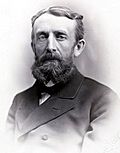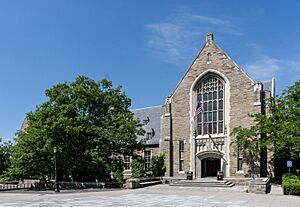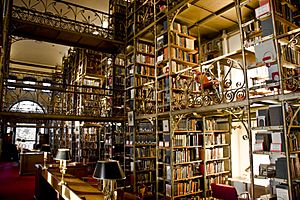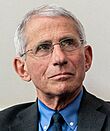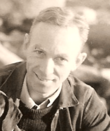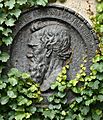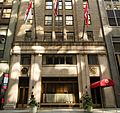Cornell University facts for kids
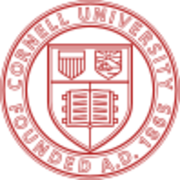 |
|
| Latin: Universitas Cornelliana | |
| Motto | "I would found an institution where any person can find instruction in any study" |
|---|---|
| Type | Private land-grant research university |
| Established | April 27, 1865 |
| Founder | |
| Accreditation | MSCHE |
|
Academic affiliations
|
|
| Endowment | $10.7 billion (2024) |
| Budget | $5.4 billion (2023) |
| President | Michael Kotlikoff |
| Provost | Kavita Bala |
|
Academic staff
|
1,639 in Ithaca, New York 1,235 in New York City 34 in Doha, Qatar |
| Students | 26,793 (fall 2024) |
| Undergraduates | 16,128 (fall 2024) |
| Postgraduates | 10,665 (fall 2024) |
| Location |
,
,
United States
42°26′57″N 76°29′2″W / 42.44917°N 76.48389°W |
| Campus | Small city, 745 acres (301 ha) |
| Other campuses | |
| Newspaper |
|
| Colors | Carnelian Red and White |
| Nickname | Big Red |
|
Sporting affiliations
|
|
| Mascot | Touchdown the Bear (unofficial) |
Cornell University is a famous private university in Ithaca, New York. It is part of the Ivy League, a group of eight top universities in the United States. The school was started in 1865 by Ezra Cornell and Andrew Dickson White. Their goal was to create a university where anyone could study anything they wanted.
From the very beginning, Cornell welcomed both men and women and was not tied to any religion. Today, students come from all 50 U.S. states and over 100 countries to study there.
The university has many different colleges and schools on its main campus in Ithaca. It also has two campuses in New York City for medicine and technology, and a medical school in Qatar. Many famous people have studied or taught at Cornell, including Nobel Prize winners, Olympic medalists, and leaders of major companies.
Contents
History
Founding a New Kind of University
Cornell University was founded on April 27, 1865. Its founders were Ezra Cornell, a businessman and senator, and Andrew Dickson White, a scholar and senator. Ezra Cornell gave his farm in Ithaca to be the university's first campus and also gave a large amount of money to get it started. White became the university's first president.
The university officially opened on October 7, 1868. On the first day, 412 male students signed up for classes.
Cornell quickly became known for its use of new technology. In 1883, it was one of the first universities to use electricity to light up its campus. It used a water-powered machine called a dynamo to create the power.
Changes and Growth
In the 1960s, like many other universities, Cornell saw a rise in student activism. Students protested about civil rights and the Vietnam War. These events led to changes in how the university was run.
Over the years, Cornell has become one of the top universities in the world. Its programs in science, engineering, and many other subjects are highly ranked.
In the 21st century, Cornell opened new campuses. In 2004, it opened a medical school in Qatar. In 2017, it opened Cornell Tech, a campus focused on technology, on Roosevelt Island in New York City.
Campuses
The Main Campus in Ithaca

Cornell's main campus in Ithaca, New York, is known for its beauty. It sits on a hill overlooking the city and Cayuga Lake. The campus is large, with a mix of old, fancy buildings and modern ones. Some buildings are so historic that they are listed as National Historic Landmarks.
The campus is surrounded by nature. Two deep gorges, Fall Creek Gorge and Cascadilla Gorge, run along its sides. These gorges have waterfalls and are popular spots for students to enjoy the outdoors. The university also owns the Cornell Botanic Gardens, a large area with beautiful plants, trees, and ponds.
Campuses in New York City

Cornell has two major campuses in New York City.
- Weill Cornell Medicine is the university's medical school, located on the Upper East Side of Manhattan. It works closely with NewYork-Presbyterian Hospital to train doctors and care for patients.
- Cornell Tech is a newer campus on Roosevelt Island. It focuses on technology and business. The city of New York helped create this campus to support the tech industry.
A Campus in Qatar
Cornell also has a medical school in Doha, the capital city of Qatar. It was the first American medical school to open outside of the United States. It offers the same high-quality medical training as the school in New York City.
Academics and Research
Cornell is a top research university, which means its professors and students work on important discoveries. The university is known for its work in science, engineering, and many other fields.
What Can You Study?
Cornell is made up of many different colleges and schools. Each one focuses on certain subjects. For example, there is a College of Engineering, a College of Arts and Sciences, and a School of Hotel Administration. Students can choose from hundreds of majors.
Some of Cornell's colleges are "statutory colleges," which means they get some funding from New York State. This makes tuition more affordable for New York residents in those programs.
Famous Discoveries and Inventions
Cornell has been a part of many amazing projects.
- Space Exploration: Cornell scientists helped with missions to Mars and discovered the rings around the planet Uranus.
- Computer Science: The university has been a leader in supercomputing for decades.
- The Chicken Nugget: Professor Robert C. Baker is credited with inventing the chicken nugget in the 1960s.
- Safety First: Early research at Cornell on car crashes led to safer cars with things like seat belts and padded dashboards.
The Library
The Cornell University Library is one of the largest university libraries in the country. It has millions of books, maps, and other materials. It was the first university library in the U.S. to let undergraduate students borrow books. The library also helps run arXiv, a famous website where scientists share their latest research.
Student Life
Clubs and Activities
With over 1,000 student organizations, there is something for everyone at Cornell. Students can join sports teams, music groups like the Cornell University Glee Club, or clubs for anything from hiking to video games.
One popular group is Cornell Outdoor Education, which offers classes in rock climbing, kayaking, and other outdoor adventures.
Fun Traditions
Cornell has many unique traditions that students love.
- Dragon Day: Every year, first-year architecture students build a giant dragon and parade it across campus. It's one of the oldest and most famous traditions at the school.
- Slope Day: On the last day of spring classes, students gather on Libe Slope, a large hill on campus, for a big celebration with music and fun.
- The Pumpkin Mystery: In 1997, students woke up to find a giant pumpkin on top of the 173-foot-tall McGraw clock tower. To this day, no one is sure how it got there.
Living on Campus
Most first-year students live on North Campus in dormitories. Older students often live on West Campus, which is set up like a series of "houses," each with its own dining hall and community. This helps students feel like they are part of a smaller group within the large university.
Cornell's dining halls are known for having great food. In fact, The Princeton Review has ranked Cornell's food among the best in the nation.
Sports
Cornell's sports teams are called the Cornell Big Red. They compete in the Ivy League against other top universities. The men's ice hockey, lacrosse, and wrestling teams are often some of the best in the country. The school's unofficial mascot is a bear named Touchdown.
Notable People
Many famous and successful people have graduated from or taught at Cornell.
Famous Alumni
- Scientists: Bill Nye "The Science Guy" is a Cornell graduate.
- Authors: E. B. White, who wrote Charlotte's Web and Stuart Little, and Nobel Prize winner Toni Morrison, author of Beloved, both attended Cornell.
- Actors: Christopher Reeve, who played Superman, and Frank Morgan, who played the Wizard in The Wizard of Oz, were Cornellians.
- Government Leaders: Ruth Bader Ginsburg, a former U.S. Supreme Court Justice, and Tsai Ing-wen, the former president of Taiwan, are both graduates.
- Business Leaders: Alumni have founded or led major companies like Burger King, Priceline.com, and Staples.
Famous Faculty
- Carl Sagan: A famous astronomer who hosted the TV series Cosmos: A Personal Voyage. He taught at Cornell for many years.
- Vladimir Nabokov: The author of the famous novel Lolita taught literature at Cornell.
- Hans Bethe: A Nobel Prize-winning physicist who worked on the Manhattan Project during World War II.
- Frances Perkins: The first woman to serve in the U.S. Cabinet. She was the Secretary of Labor and helped create Social Security. She taught at Cornell after her time in government.
Images for kids
-
Sage Chapel is a beautiful church on campus where the university's founder, Ezra Cornell, is buried.
-
Many Cornell programs have offices in the General Electric Building in Manhattan.
-
A memorial on West Campus honors Cornell students who served in World War I.
-
The Herbert F. Johnson Museum of Art, designed by famous architect I. M. Pei, is located on campus.
-
The Cornell Botanic Gardens are used for research and for students to enjoy nature.
-
Students can look at the stars at the Fuertes Observatory on North Campus.
See also
 In Spanish: Universidad Cornell para niños
In Spanish: Universidad Cornell para niños
- Cornell Law School
- Cornell Notes
- Cornell realism



